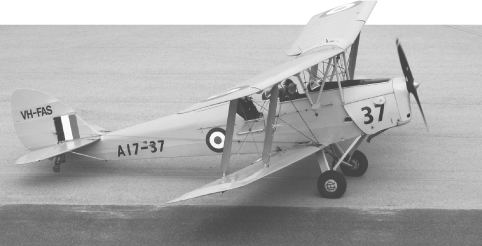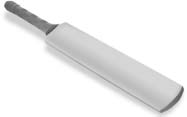
Like a streaker cavorting across the square during an afternoon’s play, our next object offers a little light-hearted relief. In fact the object in question, a Tiger Moth, did a little streak of its own on 21 January 1991, swooping out of the Australian sky as an England XI played Queensland at the Carrara Ground in Brisbane.
Yet this was more than just a prank, it was a last flight of frivolity, when tours were as much about enjoyment as they were about winning. The 1990s – as we saw with object seventy-three – heralded a new approach to cricket and sport in general. It now became a serious business – the emphasis on ‘business’ – and a win-at-all-costs mentality took hold of administrators, coaches and players. As the two Tiger Moths circled the Carrara Ground and then rose into the sky, they flew off into the sunset of amateurism.
At the controls of the two 1930 Moths were two experienced local pilots, but sitting behind them, goggled and grinning, were England cricketers David Gower and John Morris, who by a merry coincidence shared a birthday – April Fool’s Day.
That was about all they shared, in cricketing terms, at least. Morris was a competent batsman, Gower one of the greats. Born in Tunbridge Wells, Gower grew up in Africa, where his father was in the colonial service. Schooled at King’s School, Canterbury, he forsook his law studies at university to play cricket for Leicestershire. Soon he was playing for England, a batting artist, his bat a brush and the pitch his canvas. He flicked his first ball in Test cricket for four, and up in the press box old John Arlott murmured: ‘What a princely entry!’
After witnessing one of Gower’s eighteen Test centuries, Henry Blofeld was moved to write: ‘If Shakespeare had been there he would have written a sonnet.’
Off the pitch Gower acted like the last of the amateurs, crashing a car on a frozen lake, whizzing down the Cresta Run and cutting short an England press conference because he was running late for a show in the West End.
The public adored the curly-haired playboy, less so the game’s blazers. ‘From early on, it was clear that Gower and England didn’t quite hit it off,’ wrote Ian Woolridge in the Daily Mail in 1992. ‘They were professionals, Gower, for all the money he earned, was really the last amateur, a devil-may-care swashbuckler.’
But as long as Gower coloured his canvas with glorious strokes his skittishness was indulged. Until, that is, Graham Gooch came to power. Gooch, it is fair to say, is not one of life’s artists. A grafter, yes, gutsy, without doubt, and one of England’s greatest run-getters, but his narrow mind was ill equipped to deal with a maverick like Gower. When, in 1992, he wrote a book called Captaincy, Gooch dappled the text with buzz words that have since become part of the sporting vocabulary – ‘commitment’, ‘passion’, ‘attitude’ and ‘respect’. Gooch replaced Gower as captain of England in 1990, forming a trinity of – dare one say it – tyrants alongside coach Mickey Stewart and Chairman of Selectors Ted Dexter. One of their first acts was to drop Gower and the equally gifted Ian Botham from the 1990 tour to the West Indies. ‘I had no intention of wasting too much time trying to persuade Ian and David to throw themselves into the fitness training I would demand for everyone,’ explained Gooch. ‘They were set in their ways, and I wanted a fresh, dynamic attitude from all my players on that tour.’
Gower batted his way back into the squad in time for the 1990/91 tour to Australia, and he was still in good touch come the Test series. Going into the game in Queensland he’d scored a couple of centuries and one knock of 61: 94 more runs and he would surpass Geoff Boycott as England’s highest-scoring Test batsman.
But if the runs were flowing then so was the mischief. The Tiger Moth stunt was conceived to celebrate the return to form of Robin Smith, who along with John Morris had scored a century against Queensland. Morris was out, but in on Gower’s scheme, and the pair dashed to a nearby airfield and handed over $75 for a twenty-minute flight. ‘I did think of asking Graham [Gooch] but I knew he would be unhappy with us flying,’ admitted Gower later. He was dissuaded by the pilots from dropping a water bomb on to the square, but he did talk them into buzzing the ground at only 150 feet.

The public adored the curly-haired playboy, less so the game’s blazers
The England management flew into a rage at the stunt. ‘The management and captain considered it to be immature, ill-judged and ill-timed,’ declared England team manager Peter Lush, before fining each of the pair £1,000. Gower was outraged, in his own inimitable way. ‘£1,000 for a 20-minute flight is not good… and in these days of deregulation it’s scandalous.’
The British press was split on the issue, the tabloids feigning outrage at the irresponsibility of the pair, the more serious papers raising some awkward questions. Why, wondered former England bowler Mike Selvey in the Guardian, were Gower and Morris fined £1,000 when Lush chose not to fine Chris Broad a penny when he ‘refused to leave the crease in Lahore in 1987 after being given out’?
When Gooch published his book on captaincy the following year, the Guardian described it as a ‘a monument to intolerance’. So what, the paper said, if ‘Gower prefers claret to Gooch’s Sanatogen multi-vitamins, if he is sceptical of the value of the track-suited job which includes one 50-metre fast burst every 30 seconds, if he shuns the meaningful self-criticism, the deep commitment, the chemistry, the bonding, and the rest of Gooch’s dreary Stakhanovite rot’. The fact was (by this stage) he was his country’s leading runs scorer in Test cricket and ‘as beautiful and prolific a lefthander as has played for England in the last 50 years’.

If the runs were flowing then so was the mischief
Or as Australia’s Herald Sun commented on the twentieth anniversary of the Tiger Moth flight: ‘Happy anniversary, David Gower. The game still misses you.’